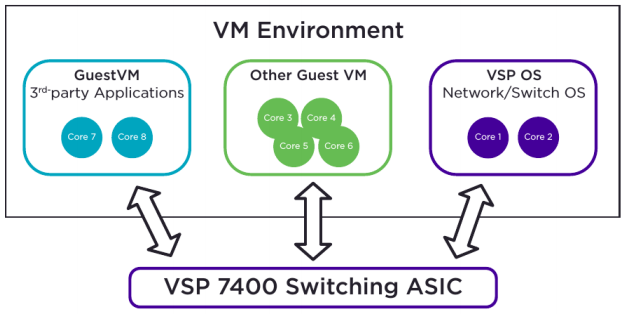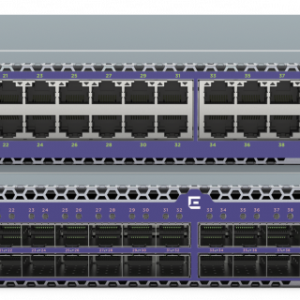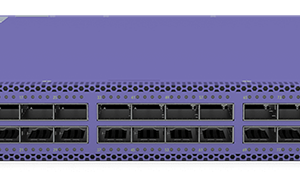Overview:
The Virtual Services Platform (VSP) 7400 Series are space-efficient, high-performance Ethernet switches, available delivering wire-speed 100 Gigabit and 25Gb Ethernet connectivity. Supporting a range of interface speeds, including 1Gb, 10Gb, 25Gb, 40 Gb and 100Gb, all in a compact 1RU form factor, the VSP 7400 Series can be flexibly deployed in either core/aggregation or spine/leaf high-density top-of-rack architectures. It also support s Extreme Fabric Connect for simplified, automated network services delivery.
Two models of the VSP 7400 Series are available:
- VSP7400-32C: Core or spine switch with 32 x 100Gb QSFP28 ports. QSFP28 ports can also be optionally run at 10Gb, 25Gb or 40Gb with channelization for high-density applications.
- VSP7400-48Y-8C: Aggregation or leaf switch with 48 x 25Gb SFP28 port s and 8 x 40/100Gb QSFP28 uplink ports. SFP28 ports on the VSP7400-48Y can also run at 1Gb, 10Gb or 25Gb to support a range of connectivity options.
The VSP 7400 can handle a variety of high bandwidth applications, including high-density 10Gb, emerging 25Gb, as well as 40Gb and 100Gb core/aggregation and spine/leaf fabric deployments. A variety of QSFP28, QSFP+, SFP28 and SFP+ transceivers are also available to support a range of fiber interface needs.
Target Applications
- High-Densit y 25 Gigabit and 100 Gigabit fixed-form switches for core, aggregation, and spine/leaf applications
- 32 ports of 100 Gigabit or 48 port s of 25 Gigabit Ethernet connectivity
- Compact 1U form factor for reduced power and footprint
- Non-blocking, wire-speed switching architecture
- Wide range of port speeds including 1Gb, 10 Gb, 25Gb, 40Gb and 100Gb
- Support s both Fabric Connect and/ or conventional Routed IP deployments
- Extreme Insight Architecture for real-time monitoring, streamlined analysis and troubleshooting
- Hot-swappable modular power and fans
- Front-to-back and back-to-front air flow options
- AC and DC power supply options
Features:
Extreme Fabric Connect
The VSP7400 Series natively support s the Extreme Fabric Connect technology. Based on an extended implementation of Shortest Path Bridging (SPB) standards of IEEE 80 2.1aq and IETF RFC 6329, Fabric Connect offers the ability to create a simplified virtualized network that simplifies network provisioning and reduces the strain on network and IT personnel. Benefit s include:
- Eliminates need to configure network-wide VLANs
- Replaces legacy protocols with a single unified protocol
- Removes the risk of network loops
- Delivers an edge-only provisioning model that seamlessly integrates with orchestration and automation
- Support s both L2 and L3 virtualization, including IP multicast routing
Traditionally, provisioning new network services required engineers to touch every device in the service path, configuring each device to enable both the active and redundant links. The bigger the network the more complex this task becomes.
Leveraging Fabric Connect delivers fundamental change. Rather than the network appearing as a mass of individual devices, it becomes a single cloud, so that engineers only need to touch the unique device that is providing service directly to the end-point. Fabric Connect instantly propagates all the end-point?s service attributes to every other node within the fabric.
Specific Fabric Connect features supported on the VSP7400 Series include: L2 Virtual Service Networks (VSNs), Layer 3 Virtual Service Networks, Inter-VSN Routing, IPv4/ IPv6 IP Shortcuts, IP Multicast over Fabric Connect, Fabric Extend and Fabric Attach Server.
Advanced Layer 3 Services
The VSP7400 Series also support s advanced Layer 3 services that enable it to satisfy conventional IP routing deployment s, in addition to it s fabric-based services. Layer 3 services include IPv4 and IPv6 dynamic routing, as well as IP multicast services.
Specific IP routing technologies supported include RIPv1/ 2, RIPng, OSPFv2/ v3, BGP/ BGP+ and VRF. Multicast services include PIM-SM/ SSM, IGMP v1/ v2/ v3, as well as Fabric Connect to PIM gateway. The VSP7400 also support s Distributed Virtual Routing (DvR) and VXLAN Gateway services.
Extreme Insight Architecture
Extreme’s Insight Architecture leverages an innovative combination of VSP7400 Series operating software and hardware features to provide pervasive visibility without impacting switching or network performance. This flexible and open solution enables organizations to deploy Extreme-provided and/ or third-party applications and tools directly on the VSP7400 system for realtime visibility.
The Insight Architecture on the VSP7400 Series consist s of a pre-configured Virtual Machine (VM) environment with support for multiple VMs. These VMs leverage the high-performance VSP7400 multi-core processor design and can be used to host applications for monitoring, troubleshooting or extended visibility into the network, based on customer need.

Figure 1: Extreme Insight Architecture on VSP7400 Series
Benefit s of the Extreme Insight Architecture on the VSP7400 Series include:
- Flexible deployment of VM-based applications within the network using the hardware resources of the VSP7400
- Ability of VM-based applications to extract data without disrupting forwarding or control plane traffic within the VSP7400
- Availabilit y of dedicated memory and SSD storage for flexible packet capture and off-line visibilit y processing
Network Intelligence
The VSP7400 Series can provide insight and intelligence into the network via it s native analytics capabilities. This includes deep packet inspection via the ExtremeAnalytics engine provided as part of the VSP7400 Insight Architecture. The VSP7400 Series also provides line-rate, hardware-accelerated IPFIX and sFlow. With these tools, the VSP7400 Series can deliver actionable insight s into both network and application performance without the need for expensive sensors or collectors.
Management
The VSP7400 Series can be managed in a variety of ways. Simple on-box management functions are delivered by a web-based GUI and a generic CLI is available for manual configuration.
For centralized management, the Extreme Management Center (XMC) delivers a comprehensive unified management capability. XMC provides a consolidated view of users, devices and applications for wired and wireless networks – from data center to edge. Zero touch provisioning let s one quickly bring new infrastructure online. A granular view of users, devices and applications with an easy to understand dashboard enables efficient inventory and network topology management.
| Specifications: | |
| VSP7400-32C | |
| Ports | – 32 x QSFP28 10 Gb/ 25Gb/40 Gb/ 100 Gb ports |
| Up to 32 x 40 Gb/ 100 Gb Ethernet interfaces | |
| Up to 124 x 10 Gb/ 25Gb Ethernet interfaces | |
| 1x Serial console port RJ-45 | |
| 1x 10/ 100/ 1000BASE-T out-of-band management port | |
| Micro-USB Type A storage port | |
| Performance | 6.4 Tbps Line-Rate Switching Capacit y (3.2 Tbps ingress, 3.2 Tbps egress) / 1,929 Mpps forwarding |
| Dimensions | 17.3in W / 22.43in D / 1.7in H |
| (44.0 cm / 57.0 cm / 4.3cm) | |
| Weight | 16.3lb (7.39kg) no PSU / 19.9lb (8.20 kg) with single PSU |
| Power Supply Options | Internal 750 W AC power supply (up to 2 PSUs) |
| Internal 750 W DC power supply (up to 2 PSUs) | |
| Front-Back and Back-Front airflow options | |
| 1+ 1redundancy | |
| Fan Tray | 6 fan modules (5 + 1redundancy) |
| Front-Back and Back-Front airflow options | |
| CPU/ Memory | 8 Core Processor |
| 16GB DDR4 ECC memory | |
| 128GB SSD memory | |
| Operating Conditions | 0º – 45ºC operation |
| 5% to 95% relative humidit y, non-condensing | |
| 0 – 3000 meters altitude | |
| Power and Heat Dissipation | |
| Minimum Heat Dissipation (BTU/ hr) (Idle, no port s linked) | 734 BTU/hr |
| Minimum Power Consumption (Watt s) (Idle, no port s linked) | 215W |
| Maximum Heat Dissipation (BTU/ hr) (100% fans, 30 ports, 100% traffic) | 1573 BTU/hr |
| Maximum Power Consumption (Watts) (100% fans, 30 ports, 100% traffic) | 461W |
General
- VSP7400-32C
- Physical Connectivity: 32 x QSFP28 ports
- Switch Fabric Architecture: 6.4 Tbps total capacity (3.2 Tbps ingress, 3.2 Tbps egress)
- Jumbo Frame support up to 9.600 bytes
- VSP7400-48Y-8C
- Physical Connectivit y: 48 X SFP28 port s + 8 x QSFP28 ports
- Switch Fabric Architecture: 4.0 Tbps total capacity (2.0 Tbps ingress, 2.0 Tbps egress)
- Jumbo Frame support up to 9,600 bytes
Performance and Scale
- Layer 2
- MAC Address: up to 160,000
- Port-based VLANs: 4,0 59
- MSTP Instances: 64
- LACP Links per Group: 8 Active
- Layer 3 IPv4 Routing Services
- ARP Entries: up to 56,000
- IP Routes: up to 16,000
- RIP Interfaces: 200
- OSPF Interfaces: 512
- BGP Peers: 256
- VRF Instances: up to 256
- Layer 3 IPv6 Routing Services
- Neighbors: up to 32,000
- IP Routes: up to 7,500
- RIPng Interfaces: 48
- OSPFv3 Interfaces: 500
- BGPv6 Peers: 256
- VRF Instances: up to 256
- Multicast
- IGMP Interfaces: 4,059
- PIM Active Interfaces: 128
- MLD Interfaces: 4,059
- IP Multicast Streams: 6,000
- Fabric Connect
- MAC Address: 80,000
- NNI Interfaces/Adjacencies: up to 256
- BEB Nodes per VSN: 2,000
- BCB/ BEB Nodes per Region: 2,000
- L2 Virtual Service Networks: 4,000
- L3 Virtual Service Networks: up to 256
- IP Shortcut Routes: IPv4 up to 16,000 and IPv6 7,500
- L2 Multicast Virtual Service Networks: 2,000
- L3 Multicast Virtual Service Networks: 256
- QoS and Filtering
- ACL non-IPv6: 512 Ingress and 254 Egress
- ACL IPv6: 384 Ingress and 256 Egress
- IPv4 ACE (Ingress): 768 each for Security and QoS (total of 1536)
- IPv4 ACE (Egress): 507
- IPv6 ACE (Ingress): 767
- IPv6 ACE (Egress): 511
- Egress Port Shaper Granularity: 1Mbps to 100 Gbps per Port
- Operations and Management
- Mirrored Ports: up to 125 when all applicable port s are channelized
- sFlow: up to 3,000 samples per second
- Fabric RSPAN: up to 1,000 VSN IDs per Region
Environmental
- Environmental Specifications
- EN/ETSI 3000 19-2-1v2.1.2 – Class 1.2 Storage
- EN/ETSI 3000 19-2-2 v2.1.2 – Class 2.3 Transportation
- EN/ETSI 3000 19-2-3 v2.1.2 – Class 3.1e Operational
- EN/ETSI 300 753 (1997-10 ) – Acoustic Noise ASTM D3580 Random Vibration Unpackaged 1.5 G
- Environmental Compliance
- EU RoHS: 20 11/ 65/ EU
- EU W EEE: 20 12/ 19/ EU
- China RoHS: SJ/ T 11363-2006
- Taiwan RoHS: CNS 15663(2013.7)
- Packaging and Storage Specifications
- Temp: -40 ° C to 70 ° C (-40 ° F to 158° F)
- Humidity: 10 % to 95% relative humidity, non-condensing
- Packaged Shock (half sine): 180 m/s2 (18 G), 6 ms, 600 shocks
- Packaged Vibration: 5 to 62 Hz at velocity 5 mm/ s, 62 to 500 Hz at0.2G
- Packaged Random Vibration: 5 to 20 Hz at 1.0 ASD w/ -3 dB/ oct. from 20 to 200Hz
- Packaged Drop Height: 14 drops minimum on sides and corners at 42 inches (<15 kg box)
Regulatory and Safety
- North American ITE
- UL 60950-1
- UL 62368-1
- Complies with FCC 21CFR 1040.10 (U.S. Laser Safety)
- CDRH Letter of Approval (US FDA Approval)
- CAN/CSA 22.2 No. 60950-1
- CAN/CSA No. 22.2 62368-1-14
- European ITE
- EN 60950-1, EN 62368-1
- EN 60825-1Class 1 (Lasers Safety)
- 2014 / 35/ EU Low Voltage Directive
- International ITE
- CB Report & Certificate per IEC 60950-1 AS/NZS 60950-1 (Australia /New Zealand)
- IEC 62368-1
- GB 4943.1-2011
- CNS 14336-1
- EMI/EMC Standards North American EMC for ITE
- FCC CFR 47 Part 15 Class A (USA)
- ICES-003 Class A (Canada)
- European EMC Standards
- EN 55032 Class A
- EN 55024
- EN 61000-3-2,2014 (Harmonics)
- EN 61000 -3-32013 (Flicker)
- EN 300 386 v1.6.1(EMC Telecommunications)
- 2014/30/EU EMC Directive
- EN 55011Class A
- International EMC Certifications
- CISPR 32, Class A (International Emissions)
- AS/ NZS CISPR32
- CISPR 24 Class A (International Immunity)
- IEC 61000-4-2 / EN 61000-4-2 Electrostatic Discharge, 8kV Contact, 15 kV Air, Criteria A
- IEC 61000-4-3 / EN 61000-4-3 Radiated Immunit y 10V/ m, Criteria A
- IEC 61000-4-4 / EN 61000-4-4 Transient Burst, 1kV, Criteria A
- IEC 61000-4-5 / EN 61000-4-5 Surge, 2 kV L-L, 2 kV L-G, Level 3, Criteria A
- IEC 61000-4-6 Conducted Immunit y,0 .15-80 MHz, 10V/ m unmod. RMS, Criteria A
- IEC/ EN 61000 -4-11Power Dips & Interruptions, >30 %, 25 periods, Criteria C
- IEC 61000-4-8 / EN 61000-4-8
- CISPER 11Class A
- GB/T 9254-200 8
- Country Specific
- VCCI Class A (Japan Emissions)
- ACMA RCM (Australia Emissions)
- CCC Mark (China)
- KCC Mark, EMC Approval (Korea)
- EAC Mark (Custom Union)
- NRCS / SABS Mark (South Africa)
- BSMI Mark (Taiwan)
- Telecom Standards
- CE 2.0 Compliant
Standards Compliance
- IEEE 802.1Bridging (Networking) and Network Management
- 802.1D MAC Bridges (a.k.a. Spanning Tree Protocol)
- 802.1p Traffic Class Expediting and Dynamic Multicast Filtering
- 802.1t 802.1D Maintenance
- 802.1w Rapid Reconfiguration of Spanning Tree (RSTP)
- 802.1Q Virtual Local Area Networking (VLAN)
- 802.1Qbp Equal-Cost Multi-Path (Shortest Path Bridging)
- 802.1Qcj Automatic Attachment to Provider Backbone Bridging (PBB) Services (Partial Support)
- 802.1s Multiple Spanning Trees (MSTP)
- 802.1v VLAN Classification by Protocol & Port
- 802.1ag Connectivit y Fault Management
- 802.1ah Provider Backbone Bridges
- 802.1aq Shortest Path Bridging (SPB) MAC-in-MAC
- 802.1X Port-based Network Access Control
- 802.1AB-2005 Station & Media Access Control Connectivit y Discovery; aka LLDP (partial support)
Based on 0 reviews
Only logged in customers who have purchased this product may leave a review.
 04 3550600
04 3550600 052 7036860
052 7036860 info@techsouq.com
info@techsouq.com





There are no reviews yet.